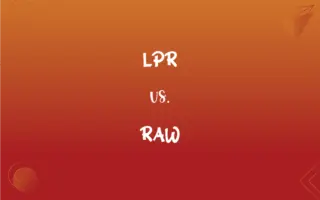Lap Winding vs. Wave Winding: What's the Difference?
Edited by Aimie Carlson || By Harlon Moss || Published on February 7, 2024
Lap Winding involves multiple parallel paths in the armature circuit, suitable for high current, low voltage; Wave Winding has two parallel paths, ideal for high voltage, low current applications.

Key Differences
Lap Winding is characterized by its parallel path configuration in the armature of a DC machine, making it suitable for high-current applications. Wave Winding is designed with only two parallel paths, regardless of the number of poles, making it more suitable for high-voltage, low-current scenarios.
In Lap Winding, each coil is connected in series with adjacent coils under the next pole, resulting in multiple parallel paths in the armature circuit. Wave Winding connects the coils in a way that forms a single continuous path, spanning all poles in a wave-like pattern.
Lap Winding is generally used in electrical machines that require large current outputs at lower voltages, such as in heavy-duty motors and generators. Conversely, Wave Winding is used in machines where high voltage and low current are needed, like in high-speed electrical machines.
The design of Lap Winding allows for more number of conductors in the armature, which increases the current capacity. In contrast, Wave Winding has fewer conductors but a higher voltage capacity due to its series configuration.
Maintenance and winding complexity differ; Lap Winding is more complex and harder to maintain due to its multiple connections, whereas Wave Winding, with fewer connections, is simpler and easier to maintain.
ADVERTISEMENT
Comparison Chart
Parallel Paths
Multiple paths
Two paths
Voltage and Current
Suitable for high current, low voltage
Suitable for high voltage, low current
Coil Connection
Coils connected under adjacent poles
Coils connected in a continuous wave-like path
Application
Used in heavy-duty motors and generators
Used in high-speed machines
Complexity
More complex and harder to maintain
Simpler and easier to maintain
ADVERTISEMENT
Lap Winding and Wave Winding Definitions
Lap Winding
Lap Winding has multiple parallel paths.
Lap Winding is used for its parallel path efficiency in motors.
Wave Winding
Wave Winding has only two parallel paths.
Wave Winding is efficient for high-speed generators.
Lap Winding
Commonly used in heavy-duty motors.
Lap Winding is ideal for this industrial motor's design.
Wave Winding
Easier to maintain due to fewer connections.
Maintaining Wave Winding is less complex than Lap Winding.
Lap Winding
Suitable for high current applications.
This motor uses Lap Winding for its heavy current requirement.
Wave Winding
Used in high-speed electrical machines.
Wave Winding is suitable for this high-speed turbine's generator.
Lap Winding
More complex in design and maintenance.
Repairing Lap Winding in motors can be challenging.
Wave Winding
Ideal for high voltage, low current.
This generator uses Wave Winding for optimal high-voltage output.
Lap Winding
Coils connected in series under each pole.
Lap Winding in this generator ensures robust power output.
Wave Winding
Forms a single continuous path across poles.
The Wave Winding pattern in this motor simplifies the design.
FAQs
What applications suit Wave Winding?
In high-speed machines requiring high voltage.
Where is Lap Winding commonly used?
In heavy-duty electrical motors and generators.
What is Wave Winding?
A winding technique with two parallel paths in the armature.
How does current capacity differ in Lap and Wave Winding?
Lap Winding supports high current, while Wave Winding supports lower current.
What is Lap Winding?
A winding method with multiple parallel paths in the armature.
Which winding is better for high voltage?
Wave Winding is more suitable for high voltage.
Is Wave Winding simpler in design?
Yes, it's simpler due to having fewer parallel paths.
Does Lap Winding require more conductors?
Yes, it generally uses more conductors.
How does Wave Winding enhance high-speed machine performance?
By providing efficient high-voltage output suitable for high speeds.
Can Lap Winding be used in small motors?
It's less common due to its design for high current output.
Is it easier to repair Wave Winding?
Generally, yes, due to its simpler configuration.
How do parallel paths in Lap Winding affect performance?
They allow for higher current capacity and power output.
How do winding techniques affect motor efficiency?
They determine the voltage and current handling, affecting performance.
Can Wave Winding be used in heavy-duty applications?
It's less common due to its suitability for high-voltage, low-current scenarios.
What type of winding is used in car alternators?
Often Wave Winding, due to the high-speed requirements.
Does Lap Winding affect the motor's voltage rating?
Yes, it's more suited for lower voltage applications.
Can Lap and Wave Winding be used interchangeably?
Not typically, as they serve different electrical specifications.
Is Lap Winding complex to maintain?
Yes, due to its multiple connections and paths.
What is a key benefit of Wave Winding?
Its efficient high-voltage output with simpler construction.
How do engineers choose between Lap and Wave Winding?
Based on the application's voltage and current requirements.
About Author
Written by
Harlon MossHarlon is a seasoned quality moderator and accomplished content writer for Difference Wiki. An alumnus of the prestigious University of California, he earned his degree in Computer Science. Leveraging his academic background, Harlon brings a meticulous and informed perspective to his work, ensuring content accuracy and excellence.
Edited by
Aimie CarlsonAimie Carlson, holding a master's degree in English literature, is a fervent English language enthusiast. She lends her writing talents to Difference Wiki, a prominent website that specializes in comparisons, offering readers insightful analyses that both captivate and inform.































































